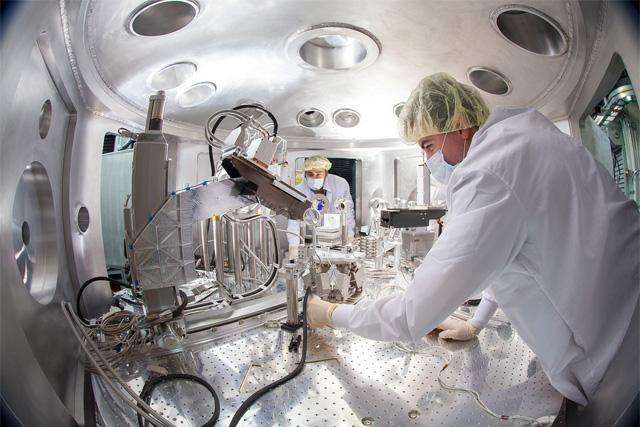Artificial photosynthesis energy research powered by X-ray lasers

Powerful new X-ray free-electron lasers (XFELs) are helping scientists inch closer to understanding how leaves draw energy from some of nature's most abundant resources – water and sunlight. This in turn, say researchers, will allow us to develop artificial photosynthesis and make it possible to create energy from sunlight and store it in liquid or gaseous form, as a solar fuel.
If taken to an industrial scale, the technology would make it possible to replace a big part of fossil fuel power generation with a new kind of solar power that even provides a supply of stored energy at night or on days when atmospheric conditions are cloudy.
The recently built Linac Coherent Light Source (LCLS) at SLAC National Accelerator Laboratory in Menlo Park, California, and the SACLA XFEL in Harima, Japan, "can really make an impact on our solar fuels research," said Uwe Bergmann, a physicist at SLAC, speaking on the sidelines of the First International Solar Fuels conference in Uppsala, Sweden.
Bergmann is convinced that by understanding what exactly happens inside a leaf, scientists might one day be able mimic some of the processes and come up with efficient, possibly self-healing and durable materials for artificial photosynthesis. For years, researchers have been trying to replicate the natural process of photosynthesis – using sunlight in order to break down water into oxygen and energy, then storing the energy in the chemical bonds of a solar fuel such as hydrogen.
"It's mind-boggling that you have a leaf, a small leaf, able to pull traces of metals in to it and then build an enormous structure of antennas and active sensors and charge separation and catalysts to work and use sunlight at room temperature and ambient pressure to produce oxygen and fuel," said Bergmann. "When you try to do it yourself you can only wonder how amazing it all is".
To build a solar-fuel generator or an artificial leaf, scientists need a catalyst that, once it absorbs sunlight, splits water into hydrogen and oxygen. There have been significant advances in this field, but scientists are still on a quest for a 'perfect' catalyst, able to liberate energy cheaply and efficiently, at room temperature and ambient pressure. It's a difficult task when you don't know precisely what actually happens inside the leaf and how the natural catalyst works at the atomic level.
The trial-and-error method of creating such a catalyst received a boost several years ago, when X-rays generated in synchrotrons have allowed researchers to study the chemical processes inside a leaf.
Unfortunately, synchrotron-based studies of bio-molecules are often hampered by radiation damage, even for cryogenically cooled samples. When studying a reaction in real time and at room temperature, these methods become even more limited.
This is where the new super-powerful X-ray sources will be of help. Their X-ray pulses are extremely bright and at the same time amazingly brief, lasting only a few femtoseconds (10−15 seconds) each - so short that they can 'freeze' the motion of molecules before any damage sets in.
During a single flash, they can focus the beam to a spot smaller than the width of a human hair, but with the same power density as all the sunlight hitting the Earth focused to a centimetre square, thus vastly expanding our ability to study the atomic structure of materials, says Janos Hajdu, a molecular biophysicist at Uppsala University in Sweden. "These are the most brilliant sources of X-rays to date, exceeding the peak brilliance of conventional synchrotrons by a factor of 10 billion."
XFELs "are expected to be able to capture the structures of the intermediate states a catalyst passes through during operation, in essence producing snapshots of chemical reactions," says Dimitrios Pantazis, biochemist at the Max Planck Institute for Chemical Energy Conversion. "Although various spectroscopic techniques can often detect intermediates of chemical reactions, there has never been any method that could provide this type of structural information."
The X-ray sources have already delivered several great results, says biochemist Petra Fromme of Arizona State University in Tempe, who uses the LCLS machine at SLAC to study proteins involved in photosynthesis by making molecular movies of the water-splitting process in leaves.
XFELs will "help unravel the secrets of solar fuel production in nature, which will provide critical insights to direct the rational design of catalysts with the efficiency of natural photosynthesis and the stability and flexibility of engineered, human-made systems," she says. "The catalysts themselves can also be analysed using XFELs to create movies that reveal their mechanism of action with atomic detail, which feed-forward critical information for improving next generation designs and technologies."
According to Fromme, the time frame for solar fuels being used on an everyday basis largely depends on funding: it could be as soon as in five years, but could also take much longer.
Provided by Institution of Engineering and Technology
This story is published courtesy of Electronics Letters. For additional Electronics Letters news and features visit theiet.org/eletters.



















